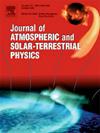利用GNSS数据估算塔什干上空ERA5对流层参数
IF 1.9
4区 地球科学
Q3 GEOCHEMISTRY & GEOPHYSICS
Journal of Atmospheric and Solar-Terrestrial Physics
Pub Date : 2025-09-27
DOI:10.1016/j.jastp.2025.106648
引用次数: 0
摘要
利用全球导航卫星系统(GNSS)信号遥感大气水汽已成为气象学、天气预报和气候研究中的一项重要技术。利用ERA5再分析的10个关键大气参数和gnss对流层延迟数据反演的可降水量(PW),研究了乌兹别克斯坦塔什干地区的大气变率。分析涵盖了2025年2月12日至22日(43-53年的一天),使用了塔什干(TASH)和迈丹塔尔(MTAL)全球导航卫星系统站的地面观测数据。主要目的是增强区域大气动力学特征,并评估gnss衍生的PW与再分析数据相结合时改善降水预报的潜力。结果显示,GNSS反演的PW值与era5反演的PW值之间存在很强的相关性,表明GNSS对流层延迟观测可靠地捕获了大气水汽的短期变化。这些发现证实了将GNSS检索结果与再分析产品结合起来对中亚大气过程进行高分辨率监测的实用性。本文章由计算机程序翻译,如有差异,请以英文原文为准。
Estimation of ERA5 tropospheric parameters using GNSS data over Tashkent
Remote sensing of atmospheric water vapor using Global Navigation Satellite System (GNSS) signals has become an important technique in meteorology, weather forecasting, and climate research. This study investigated regional atmospheric variability over Tashkent, Uzbekistan, by analyzing ten key atmospheric parameters from the ERA5 reanalysis and retrieving precipitable water vapor (PW) from GNSS-derived tropospheric delay data. The analysis covered the period from 12 to 22 February 2025 (day of year 43–53), using ground-based observations from the Tashkent (TASH) and Maidantal (MTAL) GNSS stations. The primary aim was to enhance the characterization of regional atmospheric dynamics and to evaluate the potential of GNSS-derived PW for improving precipitation forecasting when combined with reanalysis data. The results revealed a strong correlation between GNSS-derived and ERA5-derived PW values, indicating that GNSS tropospheric delay observations reliably capture short-term variations in atmospheric water vapor. These findings confirm the utility of integrating GNSS retrievals with reanalysis products for high-resolution monitoring of atmospheric processes in Central Asia.
求助全文
通过发布文献求助,成功后即可免费获取论文全文。
去求助
来源期刊

Journal of Atmospheric and Solar-Terrestrial Physics
地学-地球化学与地球物理
CiteScore
4.10
自引率
5.30%
发文量
95
审稿时长
6 months
期刊介绍:
The Journal of Atmospheric and Solar-Terrestrial Physics (JASTP) is an international journal concerned with the inter-disciplinary science of the Earth''s atmospheric and space environment, especially the highly varied and highly variable physical phenomena that occur in this natural laboratory and the processes that couple them.
The journal covers the physical processes operating in the troposphere, stratosphere, mesosphere, thermosphere, ionosphere, magnetosphere, the Sun, interplanetary medium, and heliosphere. Phenomena occurring in other "spheres", solar influences on climate, and supporting laboratory measurements are also considered. The journal deals especially with the coupling between the different regions.
Solar flares, coronal mass ejections, and other energetic events on the Sun create interesting and important perturbations in the near-Earth space environment. The physics of such "space weather" is central to the Journal of Atmospheric and Solar-Terrestrial Physics and the journal welcomes papers that lead in the direction of a predictive understanding of the coupled system. Regarding the upper atmosphere, the subjects of aeronomy, geomagnetism and geoelectricity, auroral phenomena, radio wave propagation, and plasma instabilities, are examples within the broad field of solar-terrestrial physics which emphasise the energy exchange between the solar wind, the magnetospheric and ionospheric plasmas, and the neutral gas. In the lower atmosphere, topics covered range from mesoscale to global scale dynamics, to atmospheric electricity, lightning and its effects, and to anthropogenic changes.
 求助内容:
求助内容: 应助结果提醒方式:
应助结果提醒方式:


